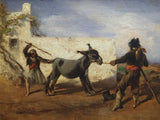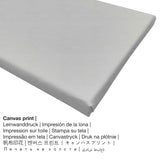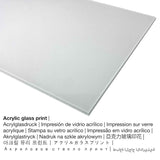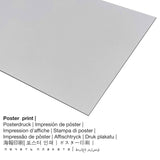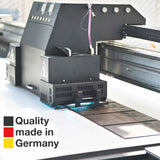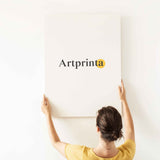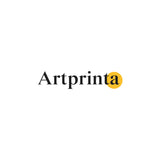Anton Romako, 1856 - Det gjenstridige eselet - kunsttrykk
Mva inkludert. Frakt beregnet Ved kassen.
De moderne kunst kunstverk The stubborn donkey was made by the historicist artist Anton Romako. The original version measures the size 26 x 34 cm - frame dimensions: 33 x 47 x 6 cm. Olje på lerret was applied by the European artist as the technique for the piece of art. Today, the artpiece forms part of the digital art collection of Belvedere in Vienna, Austria. This public domain masterpiece is included, courtesy of © Belvedere, Wien, varenummer: 1959. : dedication Hermione Eissler, Vienna in 1918. Dessuten er justeringen av den digitale reproduksjonen landskap og har et forhold på 4: 3, which means that the length is 33% longer than the width. The painter Anton Romako was an artist from Austria, whose artistic style can primarily be classified as Historicism. The artist was born in the year 1832 i Wien, Wien, Østerrike og døde i en alder av 57 i 1889.
Velg favorittvaremateriale
Vi tilbyr en rekke forskjellige materialer og størrelser for hvert produkt. Velg blant følgende produktalternativer nå for å matche dine preferanser i størrelse og materiale:
- Lerret: A UV printed canvas material mounted on a wood frame. The advantage of canvas prints is that they are relatively low in weight, which means that it is easy and straightforward to hang up your Canvas print without extra wall-mounts. A canvas print is suited for any kind of wall.
- Plakat (lerretmateriale): The poster is a printed sheet of canvas with a nice texture on the surface. It is particularly suited for placing your art replica with the help of a custom-made frame. Please bear in mind, that depending on the absolute size of the canvas poster print we add a white margin 2-6cm around the print motif to facilitate the framing with a custom frame.
- Metall (aluminium dibond trykk): Aluminium Dibond prints are prints on metal with a true depth effect. The Aluminium Dibond Print is the perfect start to replicas with aluminum. The white & bright sections of the original artpiece shine with a silk gloss but without any glare.
- Akrylglassprint (med ekte glassbelegg på toppen): A glossy print on acrylic glass, which is often labelled as a an art print on plexiglass, will turn your favorite original into décor. Beyond that, it is a viable alternative to aluminium and canvas art prints. With an acrylic glass fine art print contrasts and details become recognizeable thanks to the very fine tonal gradation of the print.
Important legal note: We try what we can in order to describe the art products as exact as possible and to exhibit them visually on the product detail pages. At the same time, the pigments of the printing material and the printing might differ slightly from the presentation on your screen. Depending on the screen settings and the quality of the surface, not all colors are printed 100% realistically. Because the fine art prints are processed and printed by hand, there may also be minor discrepancies in the exact position and the size of the motif.
Strukturerte produktdetaljer
| Artikkel kategorisering: | Wall Art |
| reproduksjon: | digital reproduksjon |
| Produksjonsmetode: | digitaltrykk |
| Produkt Opprinnelse: | produsert i Tyskland |
| Lagertype: | on demand |
| Beregnet produktbruk: | veggkunst, boligdesign |
| Orientering av bildet: | liggende format |
| Bildeforhold: | 4: 3 lengde til bredde |
| Aspektforhold implikasjon: | lengden er 33% lengre enn bredden |
| Tilgjengelige produktmaterialer: | lerretstrykk, metalltrykk (aluminiumdibond), akrylglassprint (med ekte glassbelegg), plakatutskrift (lerretpapir) |
| Størrelsesalternativer for lerret på båre (lerretstrykk): | 40x30cm - 16x12 ", 80x60cm - 31x24", 120x90cm - 47x35 ", 160x120cm - 63x47" |
| Akrylglasstrykk (med ekte glassbelegg): | 40x30cm - 16x12 ", 80x60cm - 31x24", 120x90cm - 47x35 " |
| Plakatutskrift (lerretpapir) varianter: | 40x30cm - 16x12 ", 80x60cm - 31x24", 120x90cm - 47x35 " |
| Aluminium dibond utskriftsstørrelser: | 40x30cm - 16x12 ", 80x60cm - 31x24", 120x90cm - 47x35 " |
| Ramme: | Uten ramme |
Strukturert bord over kunstverket
| Tittel på kunstverket: | "The stubborn donkey" |
| Klassifisering av kunstverk: | maleri |
| Paraplybegrep: | moderne kunst |
| Midlertidig klassifisering: | 19. århundre |
| Opprettet i året: | 1856 |
| Kunstverkalder: | over 160 år gammel |
| Medium av originale kunstverk: | olje på lerret |
| Størrelse på det originale kunstverket: | 26 x 34 cm - rammedimensjoner: 33 x 47 x 6 cm |
| Museum / samling: | Belvedere |
| Museumsplassering: | Wien, Østerrike |
| Museets hjemmeside: | www.belvedere.at |
| Tillatelse: | offentlig domene |
| Med tillatelse fra: | © Belvedere, Wien, varenummer: 1959 |
| Kreditt for kunstverk: | dedication Hermione Eissler, Vienna in 1918 |
Kort oversikt over artisten
| Artistnavn: | Anton Romako |
| Også kjent som: | romako a., a. romako, romako anton, Romako, Romako Anton, Anton Romako |
| Kjønn av artisten: | mann |
| Kunstnerens nasjonalitet: | Østerriksk |
| Jobber til artisten: | maler |
| Land for artisten: | Østerrike |
| Artistkategori: | moderne kunstner |
| Kunststiler: | historisme |
| Levetid: | 57 år |
| Fødselsår: | 1832 |
| Fødselssted: | Wien, Wien, Østerrike |
| Dødsår: | 1889 |
| Dødssted: | Wien, Wien, Østerrike |
© Copyright - Artprinta (www.artprinta.com)
Original kunstbeskrivelse av nettsiden til Belvedere (© - av Belvedere - Belvedere)
The oil painting The stubborn donkey Anton Romako was probably in 1856 during a trip to Spain by the artist and is considered the earliest surviving genre painting in his oeuvre. The contrast, saturated colors of humorous scene corresponds to the intense light of the South. The loose and sketchy brushwork acting like about works by Francisco de Goya or El Greco remember and is probably due Romako encounter with original works of Spanish painting tradition. 1860 gained Romako in Rome primarily oriented on the art market landscape views, genre paintings and portraits large financial and social recognition. After a failed marriage to the artist in 1875 returned to Vienna, where his style but not met the prevailing taste. With his increasingly bizarre and excessive design language and the emphasis on psychological moments he took elements of early expressionism anticipated. lonely in his later years and impoverished, was Romako an outsider among the historicist painters that should be rediscovered by future generations as an important reference point. [Kerstin Krenn, in: Agnes Husslein, Severin Dünser, Luisa Ziaja (ed.), Flirting with Strangers. Encounters with works from the collection, Vienna 2015, p 106.]

